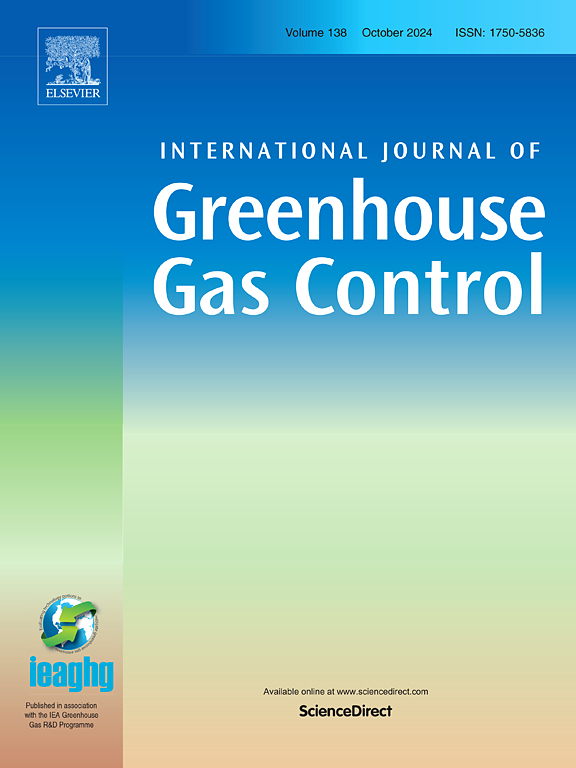Capillary pinning in sedimentary rocks for CO2 storage: Mechanisms, terminology and State-of-the-Art
IF 5.2
3区 工程技术
Q2 ENERGY & FUELS
International Journal of Greenhouse Gas Control
Pub Date : 2025-04-28
DOI:10.1016/j.ijggc.2025.104385
引用次数: 0
Abstract
Capillary pinning refers to the immobilization of CO₂ at capillary barriers when the uprising CO2 pressure is lower than the capillary entry pressure of the overlaying pore throats. Also known as local capillary trapping, it has been proposed as a fifth geologic CO₂ storage mechanism, alongside structural, solubility, residual, and mineral trapping. Despite extensive research, the fragmented terminology surrounding capillary pinning has led to confusion, making it challenging to synthesize findings effectively. Often conflated with mechanisms such as residual and hysteresis trapping, capillary pinning is commonly underestimated or completely overlooked in reservoir-scale models. Furthermore, difficulties in characterizing and upscaling small-scale geologic heterogeneities that influence capillary pinning contribute to significant uncertainties, with estimates of CO₂ trapped via this mechanism ranging from 3 % to 100 % of total CO₂ trapped via capillary actions. This review explores the fundamental mechanisms, experimental findings, and modeling approaches for assessing CO₂ capillary pinning in carbon capture and storage (CCS). It seeks to bridge the gap between the reservoir engineering community, with its extensive expertise in hydrocarbon recovery but that needs adjustments for CCS applications, and the subsurface storage community, which stands to benefit from this knowledge but often lacks access to relevant literature. Additionally, the study identifies key research opportunities to advance the understanding of capillary pinning in sedimentary rocks, ultimately enhancing the efficacy and reliability of CCS operations.
沉积岩中用于CO2储存的毛细管钉钉:机制、术语和最新技术
毛细管钉住是指当上升的CO2压力低于上覆孔喉的毛细管进入压力时,CO2在毛细管屏障处的固定作用。它也被称为局部毛细管捕集,被认为是第五种地质CO₂储存机制,与结构、溶解度、残余和矿物捕集并列。尽管进行了广泛的研究,但围绕毛细管钉钉的零散术语导致了混乱,使有效地综合研究结果具有挑战性。在储层尺度模型中,毛细管钉住作用通常被低估或完全忽略,通常与残余和滞后捕获等机制混为一谈。此外,在描述和放大影响毛细管固定作用的小尺度地质非均质性方面存在困难,这带来了很大的不确定性,通过这种机制捕获的CO₂估计占通过毛细管作用捕获的CO₂总量的3%至100%。本文综述了碳捕集与封存(CCS)过程中二氧化碳毛细管固定的基本机制、实验结果和建模方法。油藏工程界在油气开采方面拥有丰富的专业知识,但需要对CCS应用进行调整,而地下储油界则从这些知识中受益,但往往缺乏相关文献。此外,该研究还确定了关键的研究机会,以促进对沉积岩中毛细管固定的理解,最终提高CCS作业的效率和可靠性。
本文章由计算机程序翻译,如有差异,请以英文原文为准。
求助全文
约1分钟内获得全文
求助全文
来源期刊
CiteScore
9.20
自引率
10.30%
发文量
199
审稿时长
4.8 months
期刊介绍:
The International Journal of Greenhouse Gas Control is a peer reviewed journal focusing on scientific and engineering developments in greenhouse gas control through capture and storage at large stationary emitters in the power sector and in other major resource, manufacturing and production industries. The Journal covers all greenhouse gas emissions within the power and industrial sectors, and comprises both technical and non-technical related literature in one volume. Original research, review and comments papers are included.

 求助内容:
求助内容: 应助结果提醒方式:
应助结果提醒方式:


